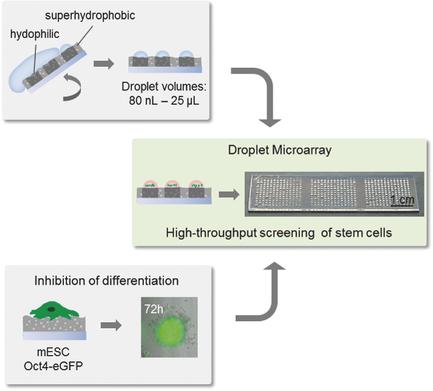当前位置:
X-MOL 学术
›
Adv. Healthcare Mater.
›
论文详情
Our official English website, www.x-mol.net, welcomes your
feedback! (Note: you will need to create a separate account there.)
Droplet Microarray Based on Patterned Superhydrophobic Surfaces Prevents Stem Cell Differentiation and Enables High‐Throughput Stem Cell Screening
Advanced Healthcare Materials ( IF 10.0 ) Pub Date : 2017-09-29 , DOI: 10.1002/adhm.201700622 Tina Tronser 1 , Anna A. Popova 1 , Mona Jaggy 2, 3 , Martin Bastmeyer 2, 3 , Pavel A. Levkin 1, 4
Advanced Healthcare Materials ( IF 10.0 ) Pub Date : 2017-09-29 , DOI: 10.1002/adhm.201700622 Tina Tronser 1 , Anna A. Popova 1 , Mona Jaggy 2, 3 , Martin Bastmeyer 2, 3 , Pavel A. Levkin 1, 4
Affiliation

|
Over the past decades, stem cells have attracted growing interest in fundamental biological and biomedical research as well as in regenerative medicine, due to their unique ability to self‐renew and differentiate into various cell types. Long‐term maintenance of the self‐renewal ability and inhibition of spontaneous differentiation, however, still remain challenging and are not fully understood. Uncontrolled spontaneous differentiation of stem cells makes high‐throughput screening of stem cells also difficult. This further hinders investigation of the underlying mechanisms of stem cell differentiation and the factors that might affect it. In this work, a dual functionality of nanoporous superhydrophobic–hydrophilic micropatterns is demonstrated in their ability to inhibit differentiation of mouse embryonic stem cells (mESCs) and at the same time enable formation of arrays of microdroplets (droplet microarray) via the effect of discontinuous dewetting. Such combination makes high‐throughput screening of undifferentiated mouse embryonic stem cells possible. The droplet microarray is used to investigate the development, differentiation, and maintenance of stemness of mESC, revealing the dependence of stem cell behavior on droplet volume in nano‐ and microliter scale. The inhibition of spontaneous differentiation of mESCs cultured on the droplet microarray for up to 72 h is observed. In addition, up to fourfold increased cell growth rate of mESCs cultured on our platform has been observed. The difference in the behavior of mESCs is attributed to the porosity and roughness of the polymer surface. This work demonstrates that the droplet microarray possesses the potential for the screening of mESCs under conditions of prolonged inhibition of stem cells' spontaneous differentiation. Such a platform can be useful for applications in the field of stem cell research, pharmacological testing of drug efficacy and toxicity, biomedical research as well as in the field of regenerative medicine and tissue engineering.
中文翻译:

基于图案化超疏水表面的液滴微阵列可防止干细胞分化并实现高通量干细胞筛选
在过去的几十年中,由于干细胞具有自我更新和分化成各种细胞类型的独特能力,因此在基础生物学和生物医学研究以及再生医学中引起了越来越多的兴趣。然而,长期保持自我更新能力和抑制自发分化仍然具有挑战性,尚未得到充分理解。干细胞不受控制的自发分化也使干细胞的高通量筛选变得困难。这进一步阻碍了对干细胞分化的潜在机制以及可能影响其分化的因素的研究。在这项工作中,纳米多孔超疏水-亲水微模式的双重功能在抑制小鼠胚胎干细胞(mESCs)分化的能力上得到了证明,同时通过不连续的去湿作用能够形成微滴阵列(液滴微阵列)。这种组合使得高通量筛选未分化的小鼠胚胎干细胞成为可能。液滴微阵列用于研究mESC干细胞的发育,分化和维持,揭示了干细胞行为对纳升和微升规模液滴体积的依赖性。观察到在微滴微阵列上培养长达72 h的mESC的自发分化受到抑制。另外,已经观察到在我们的平台上培养的mESC的细胞生长速率提高了四倍。mESC的行为差异归因于聚合物表面的孔隙率和粗糙度。这项工作表明,在长期抑制干细胞自发分化的条件下,微滴微阵列具有筛选mESC的潜力。这样的平台可用于干细胞研究,药物功效和毒性的药理学测试,生物医学研究以及再生医学和组织工程领域的应用。
更新日期:2017-09-29
中文翻译:

基于图案化超疏水表面的液滴微阵列可防止干细胞分化并实现高通量干细胞筛选
在过去的几十年中,由于干细胞具有自我更新和分化成各种细胞类型的独特能力,因此在基础生物学和生物医学研究以及再生医学中引起了越来越多的兴趣。然而,长期保持自我更新能力和抑制自发分化仍然具有挑战性,尚未得到充分理解。干细胞不受控制的自发分化也使干细胞的高通量筛选变得困难。这进一步阻碍了对干细胞分化的潜在机制以及可能影响其分化的因素的研究。在这项工作中,纳米多孔超疏水-亲水微模式的双重功能在抑制小鼠胚胎干细胞(mESCs)分化的能力上得到了证明,同时通过不连续的去湿作用能够形成微滴阵列(液滴微阵列)。这种组合使得高通量筛选未分化的小鼠胚胎干细胞成为可能。液滴微阵列用于研究mESC干细胞的发育,分化和维持,揭示了干细胞行为对纳升和微升规模液滴体积的依赖性。观察到在微滴微阵列上培养长达72 h的mESC的自发分化受到抑制。另外,已经观察到在我们的平台上培养的mESC的细胞生长速率提高了四倍。mESC的行为差异归因于聚合物表面的孔隙率和粗糙度。这项工作表明,在长期抑制干细胞自发分化的条件下,微滴微阵列具有筛选mESC的潜力。这样的平台可用于干细胞研究,药物功效和毒性的药理学测试,生物医学研究以及再生医学和组织工程领域的应用。











































 京公网安备 11010802027423号
京公网安备 11010802027423号